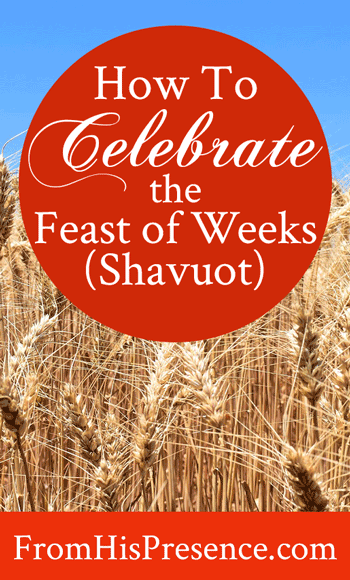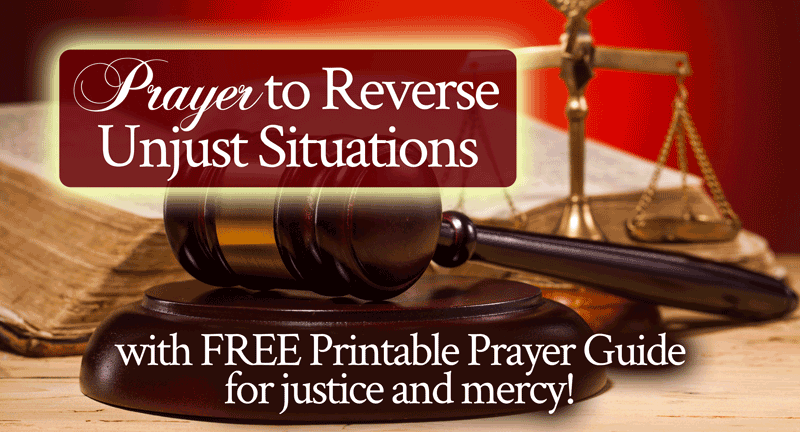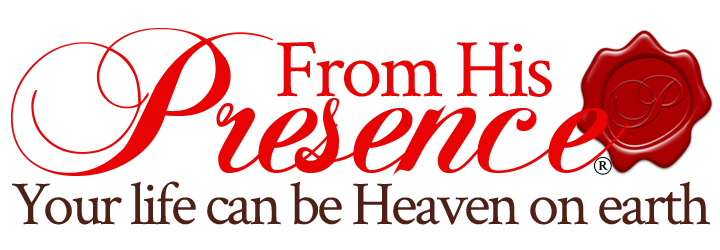Time to Celebrate the Feast of Weeks (Shavuot)–PENTECOST!
LIVE webinar: How to Hear God Prophetically For Yourself | May 10, 2024
LIVE webinar: What It Takes to Develop a $100,000 – $1,000,000 Income Blogging|May 18, 2024
 The following is a guest post from our friend and board member, Pastor Dan Brown. Pastor Dan has been teaching us periodically about how Christians can observe the Biblical feasts and festivals. And the Feast of Weeks started this week! So let’s learn together about this beautiful feast, shall we? Without further ado, I give you Pastor Dan. – Jamie
The following is a guest post from our friend and board member, Pastor Dan Brown. Pastor Dan has been teaching us periodically about how Christians can observe the Biblical feasts and festivals. And the Feast of Weeks started this week! So let’s learn together about this beautiful feast, shall we? Without further ado, I give you Pastor Dan. – Jamie
_____
When you were growing up, were you one of the children who enjoyed Advent calendars and counted the days until Christmas?
If so, when did you start counting—after Thanksgiving? After Halloween? Whenever it was, it was probably both fun and agonizingly slow in finally arriving at Christmas Day!

Get our free PDF Prayer to Reverse Unjust Situations when you sign up for our free email encouragement program!
we SEND OUT urgent PROPHETIC UPDATES AND ALL FREE GIFTS BY EMAIL ONLY, SO we HOPE YOU’LL LOVE our EMAIL program. BUT, YOU CAN UNSUBSCRIBE ANYTIME if not. no hard feelings.
Among the Feasts of the Lord, Shavuot (pronounced “shah-voo-ote”) is the only one that doesn’t have a specific date associated with it, such as Passover on Nisan 14. The Lord simply said to celebrate it fifty days after the Feast of Firstfruits (which starts 2 days after Passover). God specifically told the sons of Jacob that they were to count seven weeks from Firstfruits (Leviticus 23:15-16; Deuteronomy 16:9-10) and on the next day—the fiftieth day—this fourth feast of the year was to be observed.
This feast is also called “Pentecost” (Acts 2:1), from the Greek word which means “fiftieth.”
Because of God’s commandment to count the days, the time period from Firstfruits to Shavuot is known as Sefirah (Hebrew for “counting”). The measure of barley which was brought to the Temple as a firstfruit offering was known as the omer (Heb. for “measure, sheaf”); so with the offering of the omer, this fifty-day period is also known as “the omer” or “the counting of the omer.”
While the “counting of the omer” and a child counting the days until Christmas are two very different things, both serve to show the importance that we, and God, attach to important annual events. 🙂
Where is Shavuot described in the Bible?
There are three Scripture passages that outline the observance of Shavuot (שבועות)–the plural form of the Hebrew word for week (שבוע):
- Temple offerings were described in Leviticus 23:15-21 and Numbers 28:26-31.
- The requirements for individual worshipers were recorded in Deuteronomy 16:9-12, where they were instructed to offer freewill offerings, to rejoice before the Lord, and to remember that the Lord had freed them from the bondage of Egypt.
Why is Shavuot important?
In Bible days, and throughout the time that there was a temple in Jerusalem, Shavuot was a very important Jewish feast. It was one of the seven divinely appointed “feasts of the Lord” that was given to Israel.
Three of the seven feasts were declared by the Lord to be “solemn feasts” (Exodus 23:14-17; Deuteronomy 16:16) during which all Israelite men over the age of 20 were obligated to present themselves at the Temple. Unleavened Bread was the first of these three, followed by Shavuot and then Tabernacles in the fall.
As with the Sabbath and other feast days, this was a holy convocation or rest day (Leviticus 23:21, Numbers 28:26), and no work was permitted on these days. In Israel today, observant Jews—and most secular Jews—also do not work on these days.
What were the temple services of Shavuot like?
The Temple services for Shavuot followed a very similar pattern as that of the Feast of Firstfruits, since both holy days were celebrated with firstfruit offerings.
Shavuot, however, also included a unique offering that consisted of two long, flat, leavened loves of wheat bread as commanded by the Lord:
“You shall bring from your dwellings two wave loaves of two-tenths of an ephah. They shall be of fine flour; they shall be baked with leaven. They are the firstfruits to the Lord” (Leviticus 23:17).
The loaves were not burned, because the Lord had forbidden leaven on the altar, according to Leviticus 2:11.
Instead, these loaves and two lambs as a peace offering formed the “wave offering” for Shavuot. The priest waved them before the altar forwards and backwards, then up and down. Afterward, they were set aside for the priest and formed the festive meal eaten by the priests in the Temple.
How did Jesus fulfill all the predictions and laws of the feasts?
For the Gentile, or non-Jewish person, the different feasts mentioned above can be very confusing, especially Shavuot (the Feast of Weeks), known to believers in Jesus (the Messiah) as Pentecost.
If you’re wondering where Jesus fits in with the feasts, here is a list of the Spring Feasts and a description of how they were fulfilled through the Messiah:
- PASSOVER speaks of redemption. Messiah, the Passover Lamb, has been slain for us.
- UNLEAVENED BREAD speaks of sanctification. He was sinless and set apart. His body would not decay in the grave.
- FIRSTFRUITS speaks of resurrection. Death could not hold Him. On the third day, Jesus rose triumphantly from the grave!
- THE FEAST OF WEEKS or PENTECOST speaks of origination. The coming of the Holy Spirit inaugurated, or set into motion, the New Covenant and the Church Age, which the Messiah spoke of in the Upper Room (Matthew 26:28-29).
Jesus the Messiah arose from the dead on Firstfruits.
He then spent forty days with His disciples (Acts 1:3), telling them that He would send the Holy Spirit, which occurred ten days after His ascension—fifty days after Firstfruits and His resurrection!
During Shavuot, two loaves were brought to the Temple. They represented Jew and Gentile, now one in the Messiah with the coming of the Holy Spirit! Also, there was to be leaven in the two loaves, representing the fact that, during this age, believers have not yet been glorified and there is still sin within the Church.
So we see that each major event of Messiah’s first coming occurred on the exact date of these Jewish holidays.
From this pattern we can surmise that each of the three major events of His second coming will also fall on the appropriate Jewish holiday.
The remaining three feasts—the Feast of Trumpets, the Day of Atonement, and Tabernacles—appear to point to the Rapture of the Church and judgment of the wicked, the salvation of Israel, and the establishment of the Messianic Kingdom!
How has observing the Feast of Weeks changed?
As with Israel’s other holy days, the customs and traditions associated with Shavuot and other special days have changed over time, with the most significant changes coming about in AD 70 due to the loss of their temple, the destruction of Jerusalem, and the Jewish people being pushed out their capital city by Roman armies.
As the years following this devastating occurrence unfolded, Jewish nationalism continued to smolder among the people remaining in the land, and a second revolt was ignited under the leadership of Simon Bar Kochba. Jewish forces liberated Jerusalem in AD 132.
However, this brief victory was devastatingly crushed three years later. Around 50 fortresses and almost 1000 villages lay in ruins. Even worse, more than half a million Jews lay dead. Tens of thousands were sold into slavery and Jews were forbidden to enter their capital city.
Jerusalem was rebuilt, but was renamed Aelia Capitolina. A temple to Jupiter was erected on Mount Zion.
The Jewish people were defeated, their homeland was devastated, and they were dispersed to other lands.
Without their Temple, it was impossible for them to continue to bring offerings and to observe their feasts as outlined in the Law of Moses.
In response to this horrific crisis, the surviving religious leaders of Israel—the Sanhedrin—suggested shifting the focus of Shavuot away from its agricultural roots to the giving of the Mosaic Law (the Torah) to Moses at Mt. Sinai. This was not an arbitrary decision. Although Scripture never associated Shavuot with Mt. Sinai, the decision was made to shift the focus to the giving of the Law since, according to Exodus 19:1, this also occurred in the third month.
This idea of the Sanhedrin was quickly embraced, becoming the dominant theme of the Feast of Shavuot from the early second century on. So Shavuot soon became known as Zeman Mattan Toratenu: “The Time of the Giving of Our Torah (Law).”
How is the Feast of Weeks observed today?
In the synagogue:
It is customary to decorate synagogues with all kinds of greenery and beautiful flower arrangements for Shavuot. Some even hang an embroidered green curtain over the ark—a large, beautiful wooden cabinet—where the scrolls are stored. Others weave a canopy of flowers over the bema, the raised podium where the Torah is read.
After Shavuot was refocused to the giving of the Law, Exodus 19-20 was included in the feast’s Scripture readings.
These chapters describe God’s revelation of Himself to Moses on Mt. Sinai and the Ten Commandments. It is also customary to read the Book of Ruth in the synagogue, for two main reasons:
- The story of Ruth took place during the spring barley harvest and the beginning of the summer wheat harvest; and
- Ruth the Moabitess willingly embraced the God of Israel and His Law (Torah).
Bringing in the Torah:
One of the most beautiful sights that my wife and I observed during our time in Israel was a local congregation bringing a new Torah scroll into their synagogue.
The closest synagogue to us was about fifty yards away. As the sun set one evening in May of 2014, we were startled by the growing sound of loud music and a parade of people heading up the street just below our apartment.
Running outside to get closer, I was amazed to see various men hoisting a beautiful silver Torah case and celebrating as if it was the most precious thing that they had ever seen or touched! (For those who were holding and touching it, I believe that it was!)
There was also a large canopy—chuppah—that was carried by four people under which the Torah case began its journey, various bright lights, and a large throng of happy, dancing people. The parade of people and loud music continued all the way through the doors of the synagogue!
As I watched this procession, I couldn’t help thinking that I wish that we Christians would celebrate the Word of God as exuberantly as this crowd of Jewish people did.
Food:
One of the most popular traditions of Shavuot is the eating of dairy foods. Various rabbis have suggested that this practice is a reminder of the Law since the words of Scripture are like milk and honey to the soul.
Among the most delicious of these dairy dishes are cheesecakes, cheese blintzes, and cheese kreplach. The kreplach are similar to ravioli noodles, yet triangular in shape. The three corners of the dumpling are said to recall the statement of ancient rabbis: “Blessed be the Merciful One who gave the threefold law [Law, Prophets, and Writings] to a people made of three classes [priests, Levites, and Israelites], through a third-born child [Moses was born after Miriam and Aaron] in the third month [Sivan]” (Shabbat 88a).
It is also customary to bake two loaves of hallah bread on Shavuot. These represent the two loaves of bread offered in the Temple and the two tablets of the Law received on Mt. Sinai.
Staying up all night:
It is also customary for observant Jews to stay up the entire night of Shavuot studying and discussing the Torah, with particular emphasis on the Book of Ruth. As you can imagine, there are periodic—and much-needed—breaks for coffee and cheesecake!
As dawn approaches in Jerusalem, thousands of Jews—and a good number of Christians—make their way from the Jewish Quarter of the Old City, and other parts of the city, toward the Western Wall, close to the site of their ancient Temple. Here, they recite the ancient Amidah prayer together. The Amidah, or “standing” prayer with its nineteen blessings dates back more than 2,000 years, forming the central prayer of all Jewish prayer services.
Reasons for Christians to celebrate Shavuot:
As with all the other Jewish feasts, Shavuot is a delight for Christians to celebrate. Think about:
- the connection it provides to our spiritual ancestors;
- the expressions of gratitude to God for the spring harvest;
- the recalling of the giving of the Law to Moses and the Jewish people; and
- the joyful celebration of the coming of the Holy Spirit …
… all make this a happy and holy day that should not be forgotten or overlooked by believers in Messiah today. 🙂
So do you want to celebrate the Feast of Weeks?
If so, then kiss your Bible, read it with joy, eat some cheesecake and sweet bread, thank the Lord for His abundant blessings, ask for a fresh in-filling of the Holy Spirit, and stay up all night doing each one of these—if you’d like!
Sources:
Kevin Howard and Marvin Rosenthal, The Feasts of the Lord. Nashville, TN, Thomas Nelson, Inc., 1997.

Wow! Really good teaching! I love how Dan brought the history of the Feast of Weeks to life! And yes, I will be celebrating! I’m definitely kissing my Bible. reading to understand and to Our Father more! And let’s not forget to eat cheesecake! Don’t know that I can stay up all night however I will enjoy and cherish celebrating with our Jewish brothers and sisters in holding dear the powerful anointed Word of God! Thanks again for enlightening us! And btw, more teaching on Jewish tradition and celebration please!
Thanks so much, Angela! I’m thrilled to know that the article touched you so much! (And I’m so thankful to Jamie for asking if I would write about the feasts!)
I’m LOL’ing about the cheesecake and not staying up all night! I haven’t made it yet either! Thanks for your great interest in all things Jewish. Abba wants us to know and appreciate them!
I can’t wait to eat cheese cake and celebrate Shavuot ! God wrote the law on the tablet of stone they did not know him , but those who came to know him through the Holy Spirit he writes his law on our hearts of flesh . Soooo cool bringing the Jews and Gentiles together as one nation under God.
Hallelujah !! Love it !
This is timely and wonderful. The future of the church is tied to the feasts of the Hebrew calendar. God’s patterns are sure and permanent and all things past ….point to Messiah! Christians can celebrate with full hearts these great feasts to the Lord.
Well said, Lisa! Thanks very much! It is such a joy to understand and celebrate the feasts!
Your writing touched my heart so much. God Bless you for sharing your wisdom, wisdom that you received from The Holy Spirit.
Thank-you,Jamie1
Having these festivals explained so clearly makes them so relevant. So interesting to understand how everything is tied together, for ex. The 2 loaves representing the Jews and the Gentiles, and how the feasts line up to actual events. Sometimes these books of the bible feel “boring”, and past history, but your explanations made it all meaningful to today. I plan on reading the book of Ruth today. As we celebrate memorial day wkend. its interesting to observe and remember all our spiritual history too. Blessings!